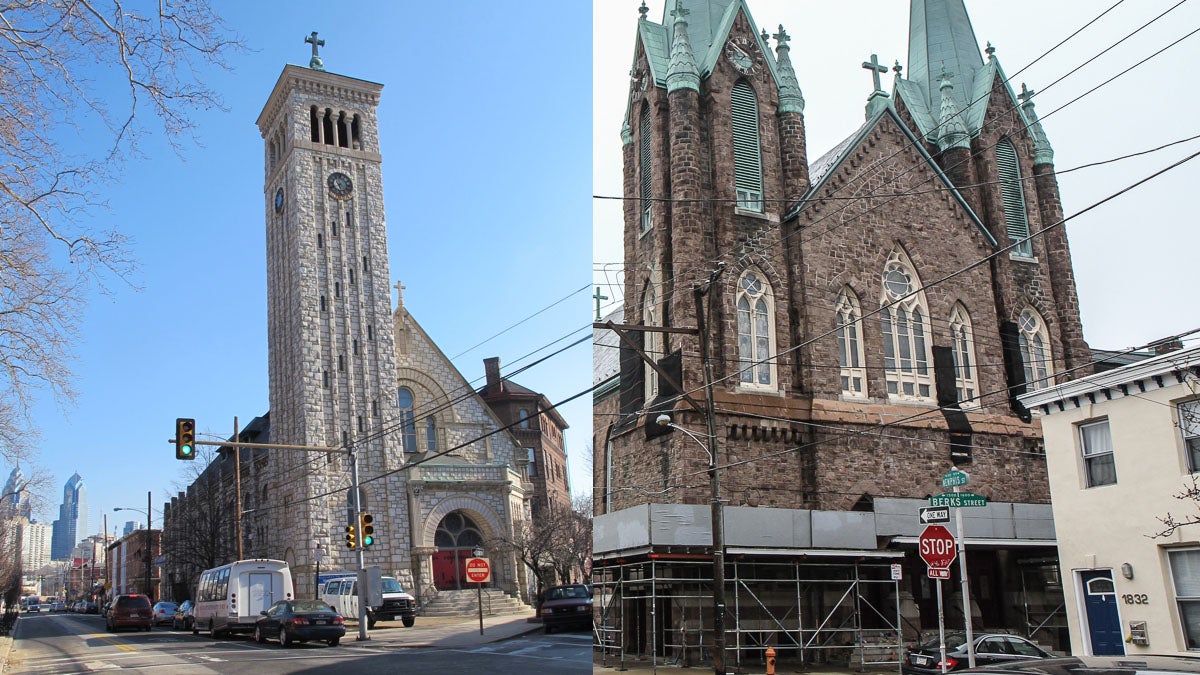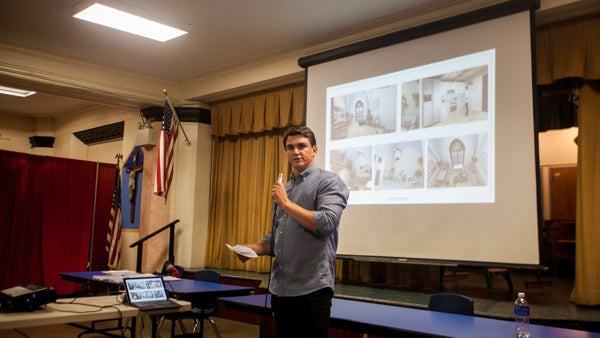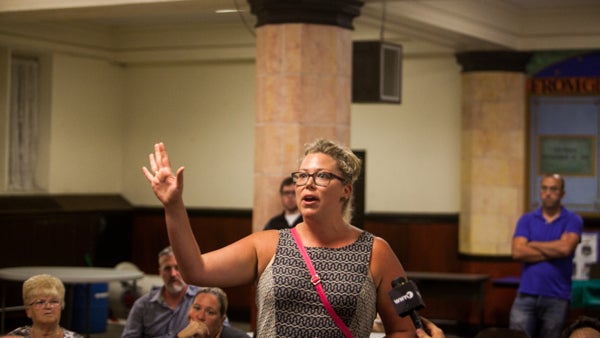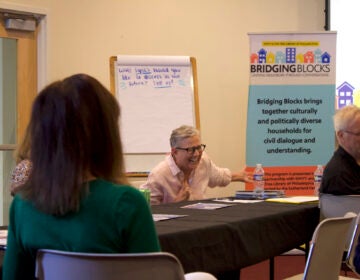A blessing for some, a cross to bear for others: Church building conversion on rise in Philly
Listen
The former Greater St. Matthew Baptist Church in South Philadelphia (left) was converted into lofts in 2014. A similar proposal has been made for St. Laurentius Church in Fishtown. (Plan Philly file photo
When Austin, Texas, transplant Melissa McCormack started her search for a Philadelphia apartment after landing a job at an IT consulting company, she came across a church.
Its looming clock tower, weathered stone exterior and stained-glass windows didn’t exactly scream upscale digs. Yet a step inside the building revealed well-lit lofts with restored hardwoods and granite countertops, among other “heavenly features,” as the developers of the Graduate Hospital site have put it. McCormack was sold.
Not all visitors and passers-by understand at first, however.
“Taxi drivers, Uber drivers are always like, ‘Are you sure this is where you want me to let you out?'” she said.
For McCormack, living in a former house of worship — renamed the Sanctuary Lofts, in this case — was more appealing than moving into a shiny new condo building.
“It feels a little less like gentrification,” she said. “Just because, at least in the case of this building, it was just standing here abandoned before.”
McCormack is helping fuel the demand for a housing trend picking up speed across Philadelphia: Old churches flipping into apartments, condos and single-family residences.
As demographic changes diminish church congregations, and more parishes merge, a glut of empty church buildings is emerging across the city.
In the Philadelphia area, the number of Catholic parishes has dropped 18 percent in the last five years, said Ken Gavin, a spokesman for the Archdiocese of Philadelphia. And the pattern reflects a national trend.
Opportunity knocking on church doors
According to the Center for Applied Research in the Apostate, there were about 19,000 parishes nationwide in 2000. Last year’s survey showed that the number has dropped to 17,000 parishes.
To developers, that’s an opportunity.
About a third of the 80 churches in Philadelphia that have been redeveloped became residential, according to Partners for Sacred Places, a Philadelphia nonprofit that assists congregations around the country preserve and adapt houses of worship.
“I am so happy that these buildings that were placed in the heart of these neighborhoods in dense urban areas are finding a second life,” said developer Leo Voloshin, who has Fishtown’s St. Laurentius under contract for apartments. “In fact, there’s many churches in Philadelphia that have been lost in the last dozen years as a result of a lack of a desire to convert, or find new use for them.”
 Developer Leo Voloshin goes over plans to convert St. Laurentius Church into 23 apartments. (Brad Larrison for NewsWorks)
Developer Leo Voloshin goes over plans to convert St. Laurentius Church into 23 apartments. (Brad Larrison for NewsWorks)
Voloshin has hopes of building 23 apartments at St. Laurentius. If he succeeds, it will be added to the nearly dozen former houses of worship in Philly have undergone a residential conversion in the last five years.
But, as Voloshin found, hurdles line the way. He expects repairs to the scaffold-surrounded church to cost $1 million, and any number of problems can arise when attempting to work inside a structure from the 1880s.
Then there’s the divided community.
At a recent packed public zoning meeting recently, Kate Davis-Horan was among those who came to express concerns. She lives right next to the empty St. Laurentius.
“Have you ever thought about perhaps making less dense units and providing some kind of service, a business perhaps, something that will add to our community, to the fabric of our community,” Davis-Horan asked Voloshin, who was grilled by residents for more than an hour.
“I don’t want to see the building get torn down, but I do think we can do better than 23 teeny-tiny units in his historical building,” Davis-Horan said after her comment to Voloshin.
Her concerns about parking and neighborhood crowding were echoed throughout the meeting.
 Kate Davis-Horan, an architect and neighbor of Saint Laurentius, expresses her concerns about the plan to turn the church into apartments. (Brad Larrison for NewsWorks)
Kate Davis-Horan, an architect and neighbor of Saint Laurentius, expresses her concerns about the plan to turn the church into apartments. (Brad Larrison for NewsWorks)
Area resident Jesse Gardner was also skeptical.
“The outside of the building is a shell,” he said. “And it’s a beautiful thing visually, but it’s very minimum in terms of asset, compared to what it could be if it’s kept as a sacred space.”
Neighborhood reservations
It’s the kind of neighborhood backlash often ignited when a housing development is proposed in an erstwhile church: some wish it could revert back to a place of worship, others want a new use that doesn’t mean adding dozens of more people to their street.
But, for developers like Voloshin, housing is the safest bet. The church’s high ceiling will even allow adding a second floor.
“Just to get enough utilization out of the building, just so we can have enough of a profit to take on the risk of preserving the building,” said Voloshin, who has also developed Paper Box Studios, a former tobacco factory in Kensington that he transformed into artist spaces.
Bob Jaeger, who leads Philly-based Partners for Sacred Places, said it’s encouraging that more and more churches are finding a second life as apartments and other housing, but the worried residents do have a point.
“I think it’s a societal question,” Jaeger said. “How do we encourage healthy transitions from congregational use to other uses?”
One issue Jaeger often hears concerning apartments in former churches is that the space ends up serving a very different role to the community than it did as a church. That doesn’t please everyone.
“Yes, people have homes, but it doesn’t house programs for the arts anymore, doesn’t serve kids anymore, doesn’t serve homeless anymore, doesn’t feed anybody anymore,” he said.
In addition to appeasing all residents, preservationists do not universally cheer when a church is eyed for redevelopment, since not all redevelopments are created equal.
“Our question is, ‘Can we encourage our neighborhoods, can we encourage our cities, to retain their public value?'” said Jaeger. “Or if they become residential, can we do it sensitively?”
One example of a local church-to-apartments conversion embraced by preservationists is the former St. Agatha’s church on 38th and Spring Garden, which, ahead of its time, was transformed into rental units more than two decades ago.
The interior walls, including the wall the held the original altar, were retained amid the apartment buildout, which is rare.
“Normally, when a sanctuary is partitioned for apartments or condominiums, almost everything is lost,” Jaeger said. “The volume is lost. The sculptures, the paintings. All the details are either shaved off or hidden away, so that’s the downside of apartment reuse.”
Voloshin and other developers say making a church into, for instance, a nonprofit community space might not pay the bills. And Jaeger points out that, without university or other institutional support, this is often the case.
“It most neighborhoods, the single-biggest demand is for residential, so developers are naturally looking to those buildings to think about how they could be sensitively used in a way that would preserve their character,” he said.
Heeding a vision
Back in Fishtown, standing in front of St. Laurentius, Voloshin said it would be a lot easier starting from the ground up. Because the building was granted a historical designation, every small change to the exterior must be approved by the Philadelphia Historical Commission. It’s not something every developer would be willing to go through.
But, he said, how could anyone rip down the oldest Polish church in the city?
“It has tall majestic spires that oftentimes have a falcon roosting on them. It has a beautiful green patina. The church is just awe inspiring,” said Voloshin. “You walk in, and look up and the baby-blue ceiling just brings it all to life.”
But if Voloshin’s dream comes true, the only people who’ll see that baby-blue ceiling will be the lucky second-floor tenants.
“People feel that they have an innate connection with the building if they move into a rehab building, as opposed to a new one.”
WHYY is your source for fact-based, in-depth journalism and information. As a nonprofit organization, we rely on financial support from readers like you. Please give today.




